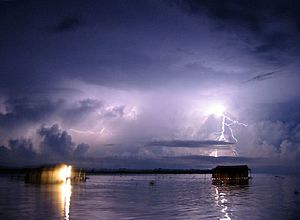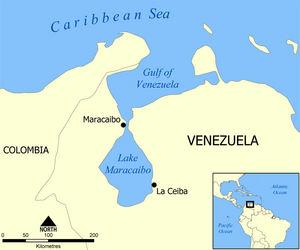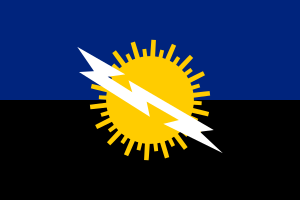Catatumbo lightning facts for kids
The Catatumbo lightning (called Relámpago del Catatumbo in Spanish) is an amazing natural light show. It happens over the Catatumbo River where it flows into Lake Maracaibo in Venezuela. The name "Catatumbo" means "House of Thunder" in the language of the Bari people.
This special lightning comes from huge storm clouds high in the sky. It happens for about 140 to 160 nights every year. Each night, it can flash for nine hours straight! You might see between 16 and 40 lightning flashes every minute. This makes it the place with the most lightning in the world, with about 250 flashes per square kilometer.
The lightning usually happens over the swampy area where the Catatumbo River meets Lake Maracaibo. The number of flashes can change throughout the year. It also varies from one year to the next. For example, the lightning stopped completely for a few months in 2010. This was likely because of a drought, which made some people worry it might be gone forever.
Contents
Where the Lightning Happens
The Catatumbo lightning usually lights up the sky to the west of Lake Maracaibo. Scientists believe these storms happen because of strong winds. These winds blow across the lake and the flat, swampy lands around it.
How the Storms Form
As these winds move, they pick up heat and moisture from the plains. Then, they hit the tall mountains nearby. These mountains include the Andes, the Perijá Mountains (which are about 3,750 meters high), and Mérida's Cordillera. These mountains surround the plains on three sides.
When the warm, moist air hits the mountains, it gets pushed upwards. This makes the air unstable and creates strong electrical charges. These charges then cause the amazing thunderstorm activity you see. Most of the lightning flashes happen inside the clouds themselves.
What Causes the Lightning?
Scientists have studied the Catatumbo lightning for many years to understand what causes it.
Early Ideas
A Russian researcher named Andrei Zavrotsky looked into the area several times. He thought the lightning came from different spots in the swamps and western Lake Maracaibo. In 1991, he suggested that the lightning happened when cold and warm air currents met. He also wondered if uranium in the ground might play a part.
Methane Gas Theory
Between 1997 and 2000, some studies suggested another idea. They thought that methane gas from the swamps and the huge oil deposits in the area were a main cause. Methane is a gas that can become electrically charged. However, other studies have shown that this idea might not be right. If methane were the main cause, there should be more lightning in the dry season. But the lightning actually happens more often in the wet season.
Modern Research
A team from the Universidad del Zulia has studied how different weather conditions affect the lightning. They found connections to things like the Inter-Tropical Convergence Zone (ITCZ) and El Niño–Southern Oscillation (ENSO). These are big weather patterns that affect the whole world. They also looked at local winds and something called "convective available potential energy" (CAPE). This energy helps storms grow.
Using satellite data, NASA has counted about 250 lightning flashes per square kilometer in the area.
Can We Predict the Lightning?
A study in 2016 showed that it might be possible to predict the lightning in the Lake Maracaibo area. We might be able to know a few months ahead of time when it will be most active. This is because the lightning is connected to predictable climate patterns. These patterns include the ENSO and the Caribbean Low-Level Jet, which is a strong wind current.
The study found that predictions are much better when using an "index." This index combines information about winds and CAPE. It helps scientists understand how different climate factors work together to create the lightning.
Cultural Importance
The Catatumbo lightning is very important to the people of Zulia state in Venezuela. Lake Maracaibo is located in Zulia. The lightning is even shown on the flag and coat of arms of Zulia state. It is also mentioned in the state's anthem.
For hundreds of years, people have called this phenomenon the "Lighthouse of Maracaibo." This is because the lightning is so bright that it can be seen for many miles around Lake Maracaibo. It helped guide sailors and travelers at night.
See also
 In Spanish: Relámpago del Catatumbo para niños
In Spanish: Relámpago del Catatumbo para niños
- Hector (cloud)





